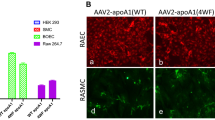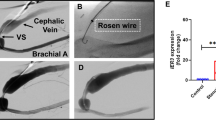Abstract
Although successful, drug-eluting stents require significant periods of dual anti-platelet therapy with a persistent risk of late stent thrombosis due to inhibition of re-endothelialization. Endothelial regeneration is desirable to protect against in-stent thrombosis. Gene-eluting stents may be an alternative allowing inhibition of neointima and regenerating endothelium. We have shown that adenoviral endothelial nitric oxide synthase (eNOS) delivery can result in significantly decreased neointimal formation and enhanced re-endothelialization. Here, we examined non-viral reporter and therapeutic gene delivery from a stent. We coated lipoplexes directly onto the surface of stents. These lipostents were then deployed in the injured external iliac artery of either normal or hypercholesterolemic New Zealand White rabbits and recovered after 28 days. Lipoplexes composed of lipofectin and a reporter lacZ gene or therapeutic eNOS gene were used. We demonstrated efficient gene delivery at 28 days post-deployment in the media (21.3±7.5%) and neointima (26.8±11.2%). Liposomal delivery resulted in expression in macrophages between the stent struts. This resulted in improved re-endothelialization as detected by two independent measures compared with vector and stent controls (P<0.05 for both). However, in contrast to viral delivery of eNOS, liposomal eNOS does not reduce restenosis rates. The differing cell populations targeted by lipoplexes compared with adenoviral vectors may explain their ability to enhance re-endothelialization without affecting restenosis. Liposome-mediated gene delivery can result in prolonged and localized transgene expression in the blood vessel wall in vivo. Furthermore, lipoeNOS delivery to the blood vessel wall results in accelerated re-endothelialization; however, it does not reduce neointimal formation.
This is a preview of subscription content, access via your institution
Access options
Subscribe to this journal
Receive 12 print issues and online access
$259.00 per year
only $21.58 per issue
Buy this article
- Purchase on Springer Link
- Instant access to full article PDF
Prices may be subject to local taxes which are calculated during checkout






Similar content being viewed by others
References
Carter AJ, Aggarwal M, Kopia GA, Tio F, Tsao PS, Kolata R et al. Long-term effects of polymer-based, slow-release, sirolimus-eluting stents in a porcine coronary model. Cardiovasc Res 2004; 63: 617–624.
Suzuki T, Kopia G, Hayashi S, Bailey LR, Llanos G, Wilensky R et al. Stent-based delivery of sirolimus reduces neointimal formation in a porcine coronary model. Circulation 2001; 104: 1188–1193.
Heldman AW, Cheng L, Jenkins GM, Heller PF, Kim DW, Ware Jr M et al. Paclitaxel stent coating inhibits neointimal hyperplasia at 4 weeks in a porcine model of coronary restenosis. Circulation 2001; 103: 2289–2295.
Virmani R, Farb A, Guagliumi G, Kolodgie FD . Drug-eluting stents: caution and concerns for long-term outcome. Coron Artery Dis 2004; 15: 313–318.
Joner M, Finn AV, Farb A, Mont EK, Kolodgie FD, Ladich E et al. Pathology of drug-eluting stents in humans: delayed healing and late thrombotic risk. J Am Coll Cardiol 2006; 48: 193–202.
Sharif F, Hynes SO, McMahon J, Cooney R, Conroy S, Dockery P et al. Gene-eluting stents: comparison of adenoviral and adeno-associated viral gene delivery to the blood vessel wall in vivo. Hum Gene Ther 2006; 17: 741–750.
Johnson TW, Wu YX, Herdeg C, Baumbach A, Newby AC, Karsch KR et al. Stent-based delivery of tissue inhibitor of metalloproteinase-3 adenovirus inhibits neointimal formation in porcine coronary arteries. Arterioscler Thromb Vasc Biol 2005; 25: 754–759.
Walter DH, Cejna M, Diaz-Sandoval L, Willis S, Kirkwood L, Stratford PW et al. Local gene transfer of phVEGF-2 plasmid by gene-eluting stents: an alternative strategy for inhibition of restenosis. Circulation 2004; 110: 36–45.
Fishbein I, Alferiev I, Bakay M, Stachelek SJ, Sobolewski P, Lai M et al. Local delivery of gene vectors from bare-metal stents by use of a biodegradable synthetic complex inhibits in-stent restenosis in rat carotid arteries. Circulation 2008; 117: 2096–2103.
Perlstein I, Connolly JM, Cui X, Song C, Li Q, Jones PL et al. DNA delivery from an intravascular stent with a denatured collagen-polylactic-polyglycolic acid-controlled release coating: mechanisms of enhanced transfection. Gene Therapy 2003; 10: 1420–1428.
Cooney R, Hynes SO, Sharif F, Howard L, O’Brien T . Effect of gene delivery of NOS isoforms on intimal hyperplasia and endothelial regeneration after balloon injury. Gene Therapy 2007; 14: 396–404.
Sharif F, Hynes SO, Cooney R, Howard L, McMahon J, Daly K et al. Gene-eluting stents: adenovirus-mediated delivery of eNOS to the blood vessel wall accelerates re-endothelialization and inhibits restenosis. Mol Ther 2008; 16: 1674–1680.
Kullo IJ, Mozes G, Schwartz RS, Gloviczki P, Crotty TB, Barber DA et al. Adventitial gene transfer of recombinant endothelial nitric oxide synthase to rabbit carotid arteries alters vascular reactivity. Circulation 1997; 96: 2254–2261.
Newman KD, Dunn PF, Owens JW, Schulick AH, Virmani R, Sukhova G et al. Adenovirus-mediated gene transfer into normal rabbit arteries results in prolonged vascular cell activation, inflammation, and neointimal hyperplasia. J Clin Invest 1995; 96: 2955–2965.
Leclerc G, Gal D, Takeshita S, Nikol S, Weir L, Isner JM . Percutaneous arterial gene transfer in a rabbit model. Efficiency in normal and balloon-dilated atherosclerotic arteries. J Clin Invest 1992; 90: 936–944.
Flugelman MY, Jaklitsch MT, Newman KD, Casscells W, Bratthauer GL, Dichek DA . Low level in vivo gene transfer into the arterial wall through a perforated balloon catheter. Circulation 1992; 85: 1110–1117.
Brito LA, Chandrasekhar S, Little SR, Amiji MM . In vitro and in vivo studies of local arterial gene delivery and transfection using lipopolyplexes-embedded stents. J Biomed Mat Res 2010; 93: 325–336.
Fishbein I, Alferiev IS, Nyanguile O, Gaster R, Vohs JM, Wong GS et al. Bisphosphonate-mediated gene vector delivery from the metal surfaces of stents. Proc Natl Acad Sci USA 2006; 103: 159–164.
Rogers C, Parikh S, Seifert P, Edelman ER . Endogenous cell seeding. Remnant endothelium after stenting enhances vascular repair. Circulation 1996; 94: 2909–2914.
Lee ER, Marshall J, Siegel CS, Jiang C, Yew NS, Nichols MR et al. Detailed analysis of structures and formulations of cationic lipids for efficient gene transfer to the lung. Hum Gene Ther 1996; 7: 1701–1717.
Schwartz B, Benoist C, Abdallah B, Scherman D, Behr JP, Demeneix BA . Lipospermine-based gene transfer into the newborn mouse brain is optimized by a low lipospermine/DNA charge ratio. Hum Gene Ther 1995; 6: 1515–1524.
Liu F, Qi H, Huang L, Liu D . Factors controlling the efficiency of cationic lipid-mediated transfection in vivo via intravenous administration. Gene Therapy 1997; 4: 517–523.
Yang JP, Huang L . Overcoming the inhibitory effect of serum on lipofection by increasing the charge ratio of cationic liposome to DNA. Gene Therapy 1997; 4: 950–960.
Nakazawa G, Granada JF, Alviar CL, Tellez A, Kaluza GL, Guilhermier MY et al. Anti-CD34 antibodies immobilized on the surface of sirolimus-eluting stents enhance stent endothelialization. JACC Cardiovasc Interv 2010; 3: 68–75.
Poppa V, Miyashiro JK, Corson MA, Berk BC . Endothelial NO synthase is increased in regenerating endothelium after denuding injury of the rat aorta. Arterioscler Thromb Vasc Biol 1998; 18: 1312–1321.
Urao N, Okigaki M, Yamada H, Adachi Y, Matsuno K, Matsui A et al. Erythropoietin-mobilised endothelial progenitors enhance reendothelialisation via AKT-endothelial nitric oxide synthase activation and prevent neointimal hyperplasia. Circ Res 2006; 98: 1405–1413.
Tsai TT, Ho PM, Xu S, Powers JD, Carroll NM, Shetterly SM et al. Increased risk of bleeding in patients on clopidogrel therapy after drug-eluting stents implantation: insights from the HMO Research Network-Stent Registry (HMORN-stent). Circ Cardiovasc Interv 2010; 3: 230–235.
Acknowledgements
This work is funded by an Enterprise Ireland Grant (CFTD 105-07). TOB is also funded by a CSET Grant to REMEDI from Science Foundation Ireland. KMC has received funding from the Health Research Board Ireland. We wish to acknowledge the help of Dr Ailish Hynes, Department of Physiology, NUI Galway, in the preparation of this manuscript.
Author information
Authors and Affiliations
Corresponding author
Ethics declarations
Competing interests
The authors declare no conflict of interest.
Rights and permissions
About this article
Cite this article
Sharif, F., Hynes, S., McCullagh, K. et al. Gene-eluting stents: non-viral, liposome-based gene delivery of eNOS to the blood vessel wall in vivo results in enhanced endothelialization but does not reduce restenosis in a hypercholesterolemic model. Gene Ther 19, 321–328 (2012). https://doi.org/10.1038/gt.2011.92
Received:
Accepted:
Published:
Issue Date:
DOI: https://doi.org/10.1038/gt.2011.92
Keywords
This article is cited by
-
Recent alternative approaches of vascular drug-eluting stents
Journal of Pharmaceutical Investigation (2018)
-
Stent-based delivery of adeno-associated viral vectors with sustained vascular transduction and iNOS-mediated inhibition of in-stent restenosis
Gene Therapy (2017)
-
Coronary Stent Materials and Coatings: A Technology and Performance Update
Annals of Biomedical Engineering (2016)



